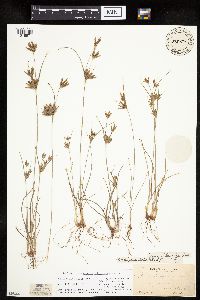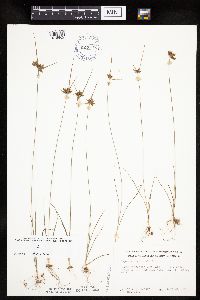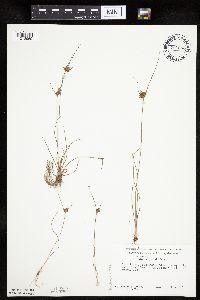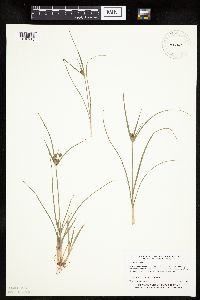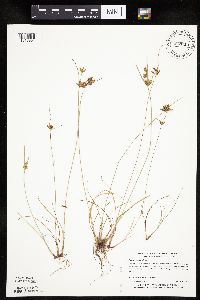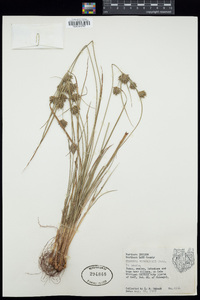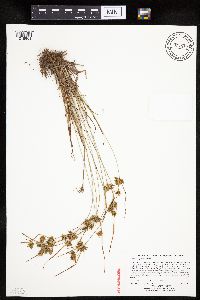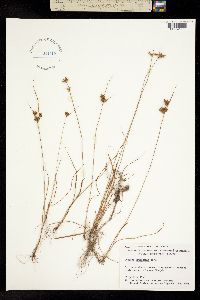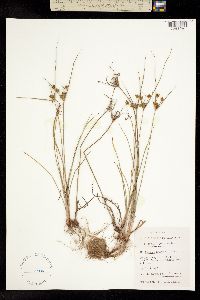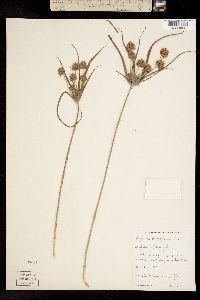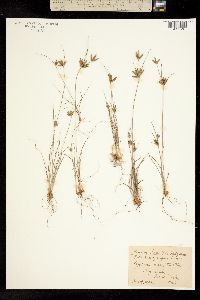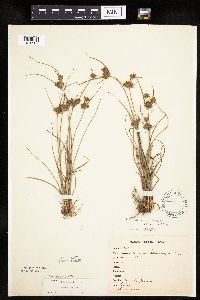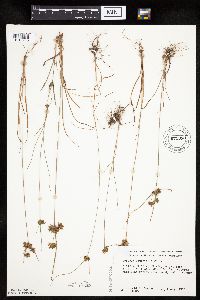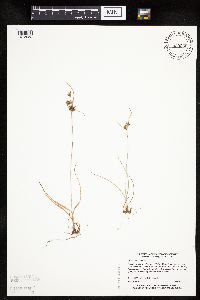Cyperus houghtonii
|
|
|
|
Family: Cyperaceae
Houghton's Flat Sedge, more...Houghton's flatsedge
[Cyperus houghtonii var. uberior] |
Herbs, perennial, cespitose, bases cormose, rhizomatous. Culms trigonous, 5-50 cm × 0.5-1.5 mm, glabrous. Leaves V-shaped, 12-30 cm × 1-6 mm. Inflorescences: spikes ± globose to broadly ovoid, 8-20 mm wide; rays 1-8 cm; rachis 2-5 mm, glabrous; bracts 3-8, weakly ascending, flat, 3-20 cm × 1-3.5 mm; rachilla deciduous, wingless. Spikelets 3-18, compressed, ovoid to oblong-lanceoloid, 4-15 × 2.6-3.4 mm; floral scales deciduous, 3-18, laterally stramineous to reddish brown, laterally 3-4-ribbed, broadly ovate, 1.8-2.5 × 1.3-1.6 mm, apex with mucro 0.1-0.2 mm. Flowers: anthers 0.5-0.7 mm; styles 0.4-0.6 mm; stigmas 1-1.5 mm. Achenes dark brown, sessile, broadly ellipsoid, 1.5-2 × 1-1.5 mm, apex obtuse, apiculate, surface glabrous, puncticulate, or papillose. 2n = 168, 170, 172. Fruiting summer. Riverbanks, sand bars, lakeshores, sand dunes, sandy openings in woods, especially among Jack pines; 0-1100 m; Man., Ont., Que.; Ill., Ind., Maine, Md., Mass., Mich., Minn., N.H., N.J., N.Y., Ohio, Pa., Vt., Va., W.Va., Wis. Perennial herb with knotty rhizomes, tufted 5 cm - 0.5 m tall Leaves: basal, alternate, 12 - 30 cm long, 1 - 6 mm wide, V-shaped in cross-section, linear, parallel-veined, keeled beneath, with a sheathing base that encloses the stem. Inflorescence: consisting of terminal spikes, subtended by spirally arranged leafy bracts. Bracts three to eight, slightly ascending, unequal, 3 - 20 cm long, 1 - 3.5 mm wide, flat. Rays (branches of inflorescence), 1 - 8 cm long. Spikes 1 - 2 cm wide, more or less spherical to broadly egg-shaped, consisting of three to eighteen spikelets. Flowers: minute, in the axil of a floral scale, lacking sepals and petals. Stamens exserted. Anthers about 0.5 mm long. Pistil one. Style about 0.5 mm long. Stigma 1 - 1.5 mm long. Fruit: a one-seeded achene, stalkless, dark brown, 1.5 - 2 mm long, 1 - 1.5 mm wide, widely ellipsoid with a small, slender point at the rounded apex, three-angled, smooth to bumpy, with concave faces. Seed with a thin, non-adherent wall. Culm: 5 cm - 0.5 m long, 0.5 - 1.5 mm wide, triangular in cross-section, solid. Spikelets: 4 - 15 mm long, 2.5 - 3.5 mm wide, compressed, egg-shaped to narrowly lance-shaped, subtended by two small bracts, with three to eighteen floral scales. Scales straw-colored to reddish brown, 1.5 - 2.5 mm long, 1 - 1.5 mm wide, widely egg-shaped with a tiny point at the apex, three- to four-ribbed, lowest one empty. Similar species: No information at this time. Flowering: June to September Habitat and ecology: This rare species has been recorded growing in cinders at railroad yards. One was also found in a Black Oak savanna. Occurence in the Chicago region: native Etymology: Cyperus is the ancient Greek word for sedge. Houghtonii is named after the Michigan geologist Douglas Houghton (1809-1845), who discovered this species. Author: The Morton Arboretum Much like no. 25 [Cyperus schweinitzii Torr.]; stems smooth, rather obtusely angled, mostly 0.5-1.5 mm thick below the infl; lvs smooth or scabrous on the margins; invol bracts divergently ascending or ±spreading, scales rotund, 2-2.5 mm, in side-view over half as wide as long, multinerved, obtuse or the uppermost minutely mucronulate; achenes 1.5-2 mm, two-thirds as thick (or a little thicker), trigonous with evidently concave faces; 2n=ca 168-172. Dry, often sandy soil, commonly with Pinus banksiana; Mass., N.H., Vt., and s. Que. to Minn. and nw. Ind.; isolated (as a waif?) in n. Va. and e. W.Va. Thought to be derived by stabilizing selection from hybrids between nos. 25 and 27 [Cyperus lupulinus (Spreng.) Marcks] but the achenes different from both. Gleason, Henry A. & Cronquist, Arthur J. 1991. Manual of vascular plants of northeastern United States and adjacent Canada. lxxv + 910 pp. ©The New York Botanical Garden. All rights reserved. Used by permission. From Flora of Indiana (1940) by Charles C. Deam This is a species of the dune area and it has been found only in Lake and Porter Counties. |





